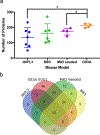Changes in proteome solubility indicate widespread proteostatic disruption in mouse models of neurodegenerative disease
- PMID: 30140941
- PMCID: PMC6411038
- DOI: 10.1007/s00401-018-1895-y
Changes in proteome solubility indicate widespread proteostatic disruption in mouse models of neurodegenerative disease
Abstract
The deposition of pathologic misfolded proteins in neurodegenerative disorders such as Alzheimer's disease, Parkinson's disease, frontotemporal dementia and amyotrophic lateral sclerosis is hypothesized to burden protein homeostatic (proteostatic) machinery, potentially leading to insufficient capacity to maintain the proteome. This hypothesis has been supported by previous work in our laboratory, as evidenced by the perturbation of cytosolic protein solubility in response to amyloid plaques in a mouse model of Alzheimer's amyloidosis. In the current study, we demonstrate changes in proteome solubility are a common pathology to mouse models of neurodegenerative disease. Pathological accumulations of misfolded tau, α-synuclein and mutant superoxide dismutase 1 in CNS tissues of transgenic mice were associated with changes in the solubility of hundreds of CNS proteins in each model. We observed that changes in proteome solubility were progressive and, using the rTg4510 model of inducible tau pathology, demonstrated that these changes were dependent upon sustained expression of the primary pathologic protein. In all of the models examined, changes in proteome solubility were robust, easily detected, and provided a sensitive indicator of proteostatic disruption. Interestingly, a subset of the proteins that display a shift towards insolubility were common between these different models, suggesting that a specific subset of the proteome is vulnerable to proteostatic disruption. Overall, our data suggest that neurodegenerative proteinopathies modeled in mice impose a burden on the proteostatic network that diminishes the ability of neural cells to prevent aberrant conformational changes that alter the solubility of hundreds of abundant cellular proteins.
Keywords: Neurodegeneration; Protein misfolding; Proteinopathy; Proteomics; Proteostasis.
Conflict of interest statement
Figures








Similar articles
-
Exploring the Role of Aggregated Proteomes in the Pathogenesis of Alzheimer's Disease.Curr Protein Pept Sci. 2020;21(12):1164-1173. doi: 10.2174/1389203721666200921152246. Curr Protein Pept Sci. 2020. PMID: 32957903 Review.
-
Molecular and functional signatures in a novel Alzheimer's disease mouse model assessed by quantitative proteomics.Mol Neurodegener. 2018 Jan 16;13(1):2. doi: 10.1186/s13024-017-0234-4. Mol Neurodegener. 2018. PMID: 29338754 Free PMC article.
-
Differential induction of mutant SOD1 misfolding and aggregation by tau and α-synuclein pathology.Mol Neurodegener. 2018 May 18;13(1):23. doi: 10.1186/s13024-018-0253-9. Mol Neurodegener. 2018. PMID: 29776378 Free PMC article.
-
Tau reduction in the presence of amyloid-β prevents tau pathology and neuronal death in vivo.Brain. 2018 Jul 1;141(7):2194-2212. doi: 10.1093/brain/awy117. Brain. 2018. PMID: 29733334 Free PMC article.
-
Amyloid-induced neurofibrillary tangle formation in Alzheimer's disease: insight from transgenic mouse and tissue-culture models.Int J Dev Neurosci. 2004 Nov;22(7):453-65. doi: 10.1016/j.ijdevneu.2004.07.013. Int J Dev Neurosci. 2004. PMID: 15465275 Review.
Cited by
-
Myelin in Alzheimer's disease: culprit or bystander?Acta Neuropathol Commun. 2023 Mar 31;11(1):56. doi: 10.1186/s40478-023-01554-5. Acta Neuropathol Commun. 2023. PMID: 37004127 Free PMC article. Review.
-
Impaired Aggrephagy, Interrupted Vesicular Trafficking, and Cellular Stress, Lead to Protein Aggregation, and Synaptic Dysfunction in Cerebellum of Children and Adults with Idiopathic Autism.Cerebellum. 2025 Aug 8;24(5):140. doi: 10.1007/s12311-025-01880-5. Cerebellum. 2025. PMID: 40779003 Free PMC article.
-
Widespread remodeling of proteome solubility in response to different protein homeostasis stresses.Proc Natl Acad Sci U S A. 2020 Feb 4;117(5):2422-2431. doi: 10.1073/pnas.1912897117. Epub 2020 Jan 21. Proc Natl Acad Sci U S A. 2020. PMID: 31964829 Free PMC article.
-
4E-BP1 Protects Neurons from Misfolded Protein Stress and Parkinson's Disease Toxicity by Inducing the Mitochondrial Unfolded Protein Response.J Neurosci. 2020 Nov 4;40(45):8734-8745. doi: 10.1523/JNEUROSCI.0940-20.2020. Epub 2020 Oct 12. J Neurosci. 2020. PMID: 33046555 Free PMC article.
-
Protection against Aβ-induced neuronal damage by KU-32: PDHK1 inhibition as important target.Front Aging Neurosci. 2023 Nov 14;15:1282855. doi: 10.3389/fnagi.2023.1282855. eCollection 2023. Front Aging Neurosci. 2023. PMID: 38035268 Free PMC article.
References
-
- Ayyadevara S, Balasubramaniam M, Parcon PA, Barger SW, Griffin WST, Alla R, Tackett AJ, Mackintosh SG, Petricoin E, Zhou W, Shmookler Reis RJ (2016) Proteins that mediate protein aggregation and cytotoxicity distinguish Alzheimer’s hippocampus from normal controls. Aging Cell 15:924–939. doi: 10.1111/acel.12501 - DOI - PMC - PubMed
-
- Bai B, Hales CM, Chen P, Gozal Y, Dammer EB, Fritz JJ (2013) U1 small nuclear ribonucleoprotein complex and RNA splicing alterations in Alzheimer ‘ s disease. Proc Natl Acad Sci U S A 110:16562–16567. doi: 10.1073/pnas.1310249110/-/DCSupplemental.www.pnas.org/cgi/doi/10.1073/pnas.1310249110 - DOI - PMC - PubMed
Publication types
MeSH terms
Substances
Grants and funding
LinkOut - more resources
Full Text Sources
Other Literature Sources
Medical

